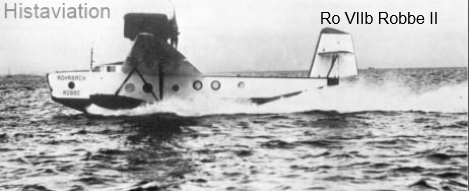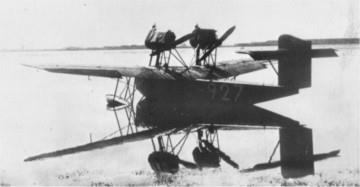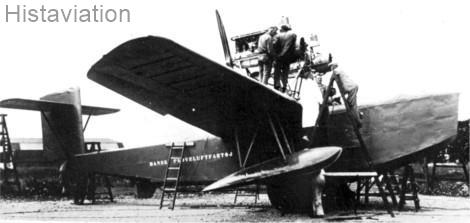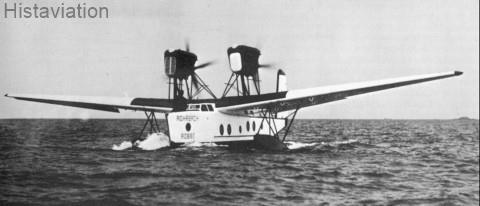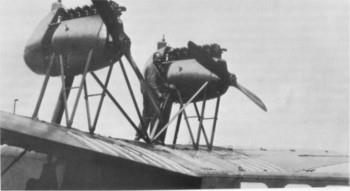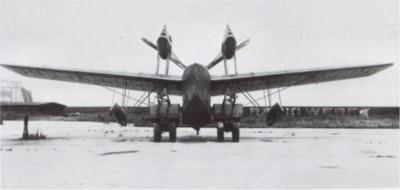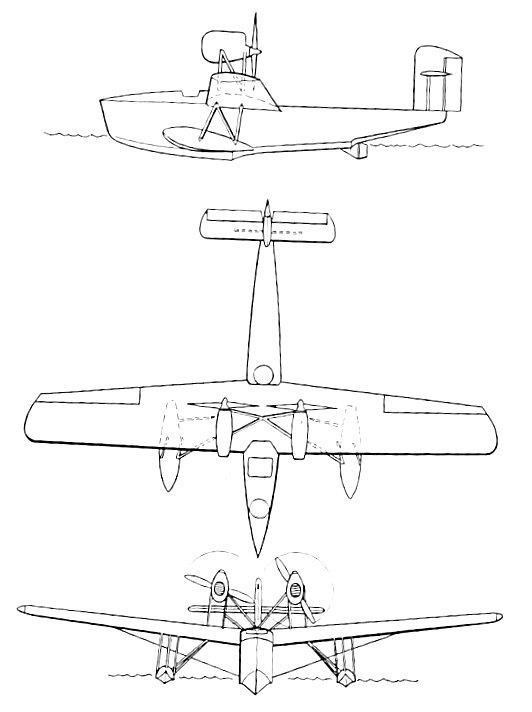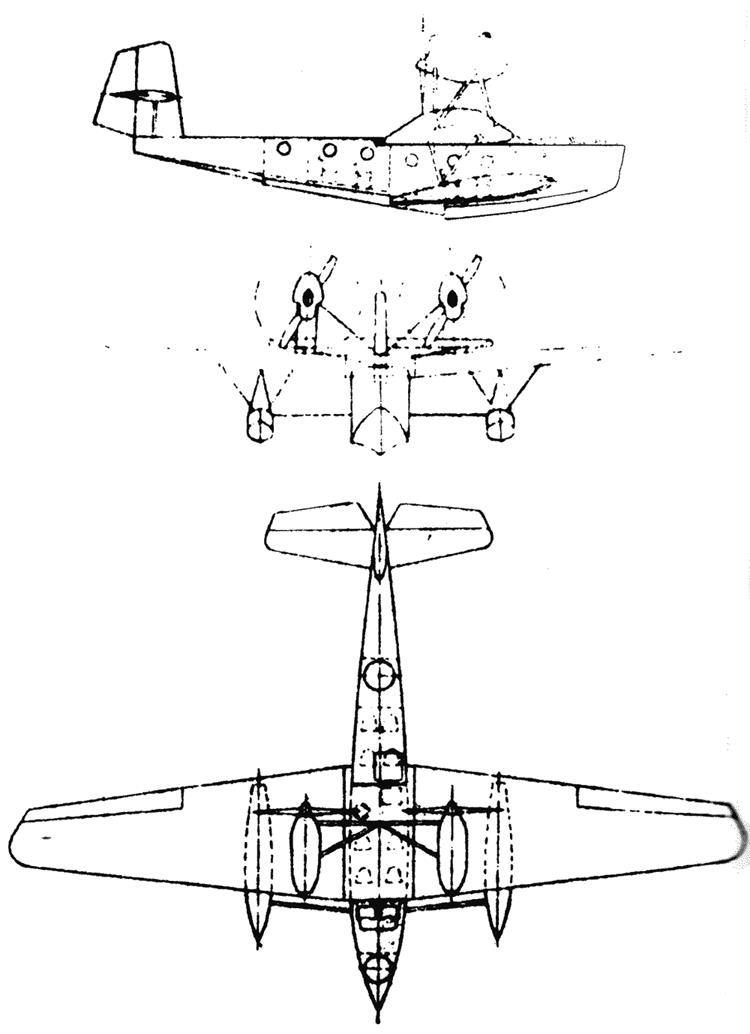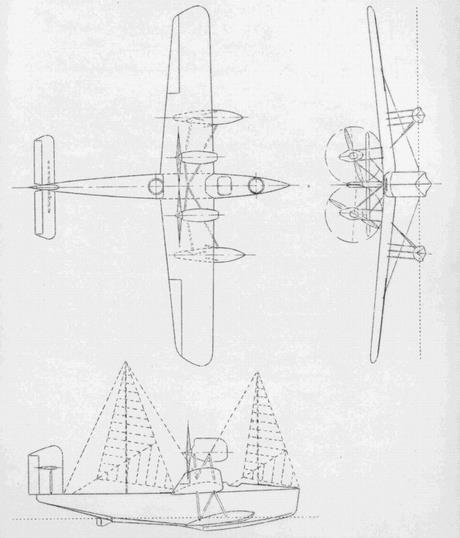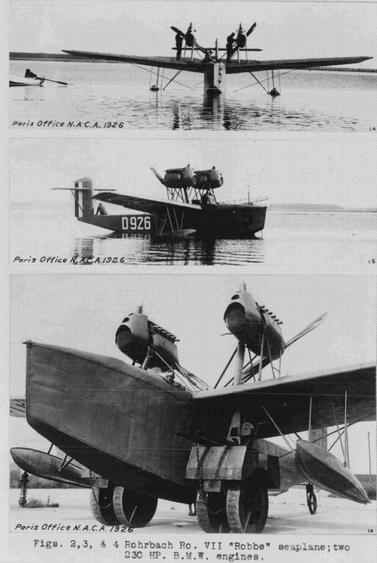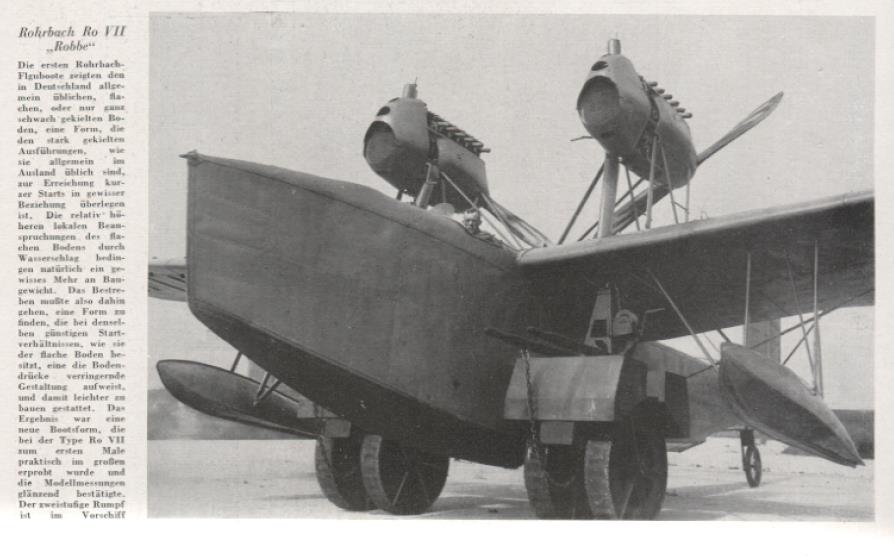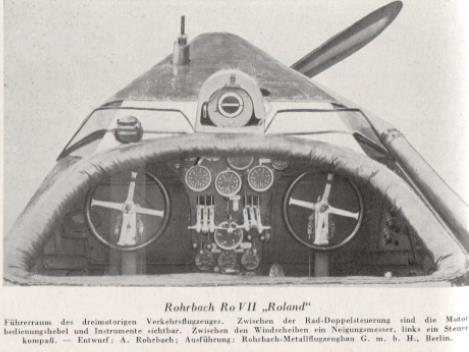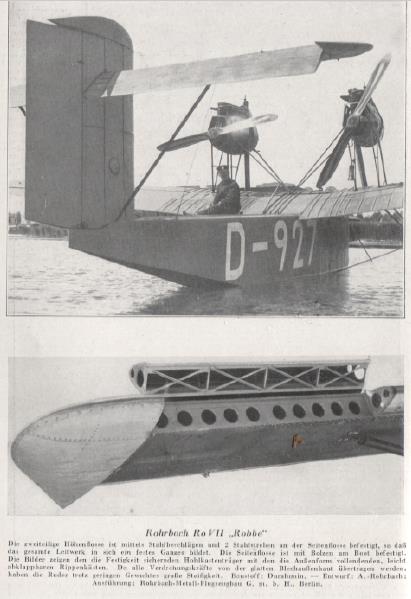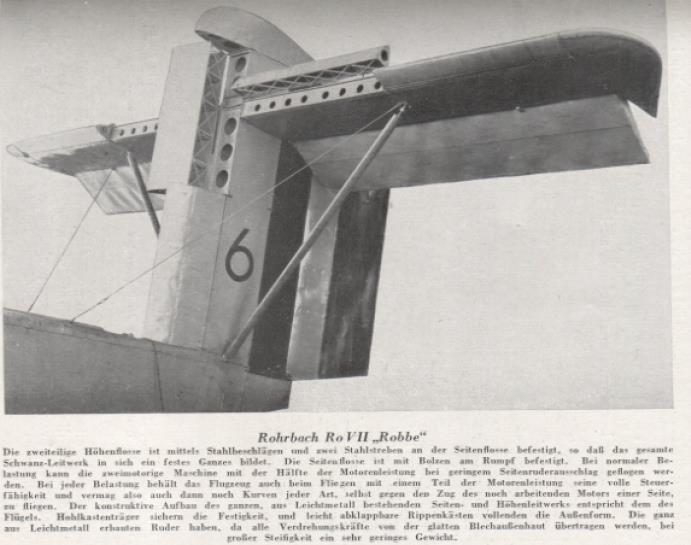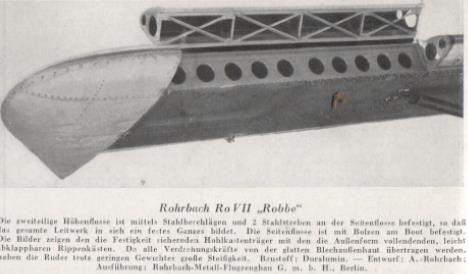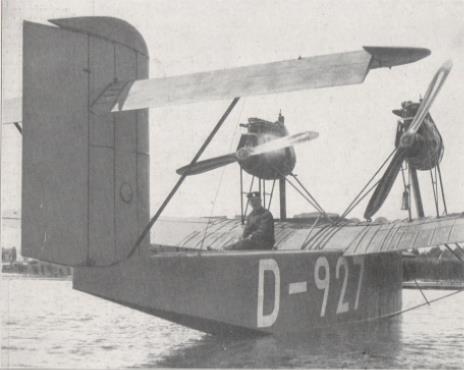Ro VIIb Robbe II
THE ROHRBACH "R0BBE" RO VII SEAPLANE Source NATIONAL ADVISORY COMMITTEE FOR AERONAUTICS.AIRCRAFT CIRCULAR NO. 36.
(Military or Commercial).
In the design of this seaplane. Dr. Rohrooch his chosen
the tapered wings, both in chord and ordinate. It will be recalled that in previous designs he used wings of uniform chord and ordinate from root to tip. An all-metal, construction similar to former types has been retained with a somewhat un- usual feature in the pronounced "V" bottom of the hull, especially in front of the main step. The wing floats are still used for the purpose of stabilising the seipline on the water, this being particularly necessary in this design with the main hull relatively narrow and high and the engines a considerable distance above the wing, placing the center of gravity nther high.
TheRo VII seaplane can be equipped for either military or commercial use, the hull being sufficiently large to accommodate four passengers, with pilot and mechanic occupying the
cockpit above.
General Characteristics
The plates and open profiles of duralumin permit of easy control and preservation, with the possibility of inspection of all rivet heads from both sides. All individual parts are detachable and interchangeable, hence easily assembled, with perfect attendance and prompt repair. The metal covering of hull and wing can be walked on with perfect ease and safety. Great strength is combined with low weight. The wing components consist of a central hollow box girder, front nose-rib boxes, and rear end-rib boxes. The rib boxes are detachable for the purpose of inspection of inner wing; structure with the nose- and end-rib boxes partially designed as gasoline tanks, giving increased range due to augmented tank capacity. The tail-plane unit is of similar design to that of the wing, hollow box girder and rib boxes being used-
A monoplane wing is used with a pronounced dihedral and a semicantilever design, with bracing from the hull by means of wires. Each ring half is secured to hull by means of steel fittings and bolts- and can be walked upon with perfect ease. Two steps are provided in the hull, the front being of a pronounced hollow V-shape up to main step, and the rear of a pronounced V-shape. The boat form insures convenient distribution of bottom forces and smooth landing. No porpoising is experienced at start and there is no spraying. Cruiser stem with towing, anchoring ring end belaying cleat for ropes are provided.
The floats are of boat-like design with V-shaped bottom and braced against wing by streamlined, easily interchangeable struts with a subdivision by means of two bulkheads into three watertight compartments. Drain screws are provided in each compartment and tight hand-holes fflth the possibility of glass covering.
Six bulkheads subdivide the hull into seven water-tight compartments. A central locking device permits of immediate closing of the water-tight doors in case of danger. The arrangement of bulkheads allows any two compartments to be flooded without sinking or capsizing the hull.
Two water-cooled BMW IV engines of 230 KP. each are used and mounted well above the wings on steel tubes of streamlined section with steel fittings. Gasoline is carried in the nose- and end-rib boxes with gasoline delivery to carburetor by means of pump. The engine controls are operated by means of rods The oil tanks are situated in the engine nacelles and the radiators in front of engine with a ventilator, behind the radiators, operated from the pilot's seat- The reserve tanks are above the engines.
Hand-wheel controls are used with rods leeding to aileron and elevator. The controls for the vertical surfaces consist of foot lever with rods leading to the rudder. Dual control can be installed as required. In the pilots cock-pit seats are arranged side by side in fore-boat in front of wing v/ith good vision in all directions- The seats are upholstered and equipped with safety straps.
The control levers, throttle, ignition, fire-cock, fire extinguisher are all within easy reach of the pilot- One common board contains the navigation and engine instruments-
The hull, fitted as a cabin accommodates, as previously mentioned, four passengers, one of whom occupies the fore-cabin, one the rear-cabin, and the remaining two the intermediate cabin. Two seats are hinged.
A prooeller-driven generator with storage battery furnish the current for position lights, searchlights and heating. A wireless outfit is contemplated.
Load Factors for a Weight of Flying Structure of 3150 kg (6945 lb.)
Case A (high incidence) 5,0
Case B (low incidence) 0,7 (A + C)
Case C (maximum speed of dive) 2,0
Case D (inverted flying) 2,4
Elevator control 250 kg/m2 (51,.2 (breaking load)
Vertical fin and rudder 205 kg/m2 (42,0 lb./sq.ft (breaking load)
Metacentric height 8.5 m (27,89 ft.)
Record flights on 23/8 1926 (FAI) :
1) 186 km/h over 100 km with 500 kg load
2) 180 km/h over 500 km with 500 kg load
3) 186 km/h over 100 km with 1000 kg load
4) 180 km/h over 500 km with 1000 kg load
5) Transport of 1000 kg over 519 km.
Pilot was Werner Landmann
| Type |
a 2 + 4 seat flying boat (Military : Reconnaissance ) |
b 2 + 6 seat experimental flying boat |
| Engine |
2 BMW IV 2 x 460 hp |
2 BMW VIa 2 x 600 hp |
| Dimensions |
Length 13.2 m, height 5.5 m, span 17.4 m, wing area 40 m2, aspect ratio
7.57 |
Length 15.2 m, height 5.90 m, span 21.5 m, wing area 55 m2, aspect ratio
8.4 |
| Weights |
Empty , loaded , max. take off weight Empty 2000 kg, fuel 484 kg, oil 50 kg, crew 160 kg, payload 666 kg, load 1360 kg, flying weight 3360 kg wing loading 84,00 kg/m2 power loading 7,30 kg/hp |
Empty 3600 kg, fuel 1200 kg, oil 70 kg, crew 160 kg,payload 650kg, flying
weight 5680 kg wing loading 103,27 kg/m2 power loading 4,73 kg/hp |
| Performance |
Max. speed 210 km/h at 2000 m, max. speed at sea level 195 km/h cruising speed at sea level 180 km/h,climb to 1000 m 5 min., to 2000 m 10 min., to 3000 m 16 min., landing speed 116 km/h, service ceiling 4500 m, range 1200 km at 180 km/h km, endurance 4.75 h |
Max. speed 224 km/h at sea level, cruising speed 200 km/h at sea level,
landing speed 135 km/h, service ceiling 4300 m, range 1200 km,
|
| Type |
Werk.Nr |
Registration |
History |
| VII Robbe I |
20 |
D-926 |
Took part in the Seeflugwettbewerb in 1926. On 22/7 it had to land because of engine failure.Was not allowed to continue in the competition. Sold to DVS |
| VII Robbe I |
21 |
D-927 |
Took part in the Seeflugwettbewerb in 1926. On 15/7 the right propeller broke into parts, damaging the ailerons and the left propeller. Emergency landing, but after repair did not finish the competition. Sold to DVS |
| VIIb Robbe II |
|
|
Built in 1927. During record trial with Udet and Tank as pilots it had to do an emergency landing with minor
damages as a result. The aircraft was towed to shore and there after dismanteled. Parts were used for the Ro XI |
Ro VII Robbe I
Ro VIIb Robbe II
